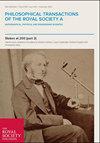M-V火箭的姿态控制设计
Philosophical Transactions of the Royal Society of London. Series A, Mathematical and Physical Sciences
Pub Date : 2001-11-15
DOI:10.1098/rsta.2001.0887
引用次数: 10
摘要
本文研究了日本科学卫星运载火箭M-V运载火箭的一级姿态控制设计算法。该控制具有增强的鲁棒性,可以抵抗一系列系统参数的不确定性。为了获得足够的鲁棒性,在H∞混合灵敏度问题的框架内对该问题进行了研究。重点讨论了如何将鲁棒控制理论应用于复杂的实际问题。在设计中,对标准工艺进行了特殊的修改。在使用标准设计过程之前,通过直接输出反馈初步稳定了原始的,不稳定的植物动力学。然后将标准理论应用于这些预稳定的植物动力学中进行产量控制。控制器的最终形式由其与预先指定的反馈的组合提供。这一程序的修改是由于它在不稳定的系统中并不总是有效。因此,可以更容易地推导出控制器。该飞行器的首次飞行成功地将世界上第一颗射电天文卫星送入轨道,最终证实了该设计的有效性。本文章由计算机程序翻译,如有差异,请以英文原文为准。
Attitude control design of the M–V rocket
This paper deals with the design algorithm of the first–stage attitude control for the M–V launch vehicle, Japan's scientific satellite carrier. The control features enhanced and robust characteristics against a range of uncertainties of the system parameters. To achieve sufficiently robust characteristics, the problem is approached within the framework of the H∞ mixed sensitivity problem. The emphasis is put on how to apply the robust control theory to a complicated real problem. In the design, the standard process is modified in a special way. The original, unstable plant dynamics are preliminarily stabilized by a direct output feedback prior to using the standard design process. Then the standard theory is applied to these pre–stabilized plant dynamics to yield control. The final form of the controller is provided by its combination with the pre–specified feedback. This modification of the procedure is prompted by the fact that it is not always effective in unstable systems. Thus, the controller can be derived much more easily. The effectiveness of the design has been finally established by the first ever flight of the vehicle successfully putting the world's first radio astronomy satellite into orbit.
求助全文
通过发布文献求助,成功后即可免费获取论文全文。
去求助
来源期刊
自引率
0.00%
发文量
0

 求助内容:
求助内容: 应助结果提醒方式:
应助结果提醒方式:


